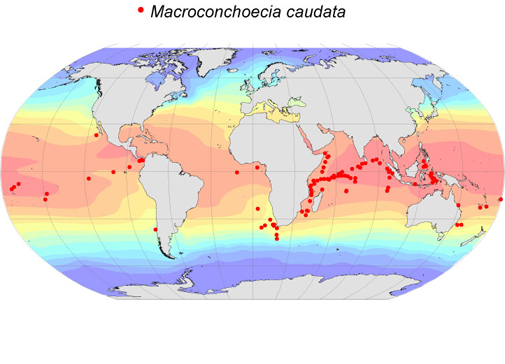Atlas of Atlantic Ostracods
Taxon details
Macroconchoecia caudata (Müller, G.W., 1906)
- Order:
- MYODOCOPA
- Suborder:
- Halocypridina
- Family:
- Halocyprididae
- Subfamily:
- Conchoecinae
- Size range (females):
- 7.0-7.8 mm
- Size range (males):
- 5.7-6.0 mm
- Depth:
- epi-/mesopelagic
Notes
108 records
This species with its enormously long spine extensions of both rostra and an even longer spine on the posterior dorsal corner of the right carapace valve, its clear polygonal sculpture and shoulder vaults armed with rows of spines, is unmistakable. Its geographical range is from 40°S to 23°N in the California Current, 11°N in the Western Indian Ocean and 3°N in the Atlantic. It is predominantly an Indo-Pacific species that occurs spasmodically in the South Atlantic. It seems possible that its appearances in the South Atlantic result from its advection in the mesoscale eddies, which are spawned from the Agulhas retroflection to the south of the Cape of Good Hope and so introduce Indian Ocean water into the South Atlantic. Müller (1906) originally placed it in his ‘Spinifera’ group of species. Granata and Caporiacco (1949) proposed the genus Macroconchoecia for M. reticulata, which Sylvester-Brady (1961) designated as the type species. Poulsen (1973) placed M. reticulata in his new genus Paraconchoecia that he erected to accommodate the species in Müller’s ‘spinifera group’. Ellis (1984) redescribed both M. reticulata and M. caudata and described two new species that had originally been included in the former, She retained all four species in Conchoecia, but it is now appropriate to classify them in Macroconchoecia as these four species are quite distinct from the Paraconchoecia species. caudata is exceptional member of the genus in that it is a mesopelagic species generally caught at depths of 200-600m, whereas the other species are bathypelagic or even abyssopelagic. Normally we measure halocpyrids by laying them on their backs and measuring their lengths from the tip of the rostrum (or anterior margin if the rostrum is not visible) to posterior point of the carapace, but in this case since the long spines are so often broken or bent, the length is measured from the anterior to the posterior margins of the carapace. If the spines are intact, they effectively double the length of the specimen, the rostal spine being 41-47% of the carapace length and the posterior spine 49-54%.
| All | n | Mean mm* | s.d. | Range mm |
|---|---|---|---|---|
| Female | 28 | 3.32 | 0.116 | 3.08-3.56 |
| Male | 17 | 2.94 | 0.214 | 2.48-3.24 |
| A-1 | 65 | 2.33 | 0.137 | 1.80-2.52 |
| A-2 | 35 | 1.58 | 0.054 | 1.40-1.64 |
| A-3 | 6 | 1.10 | 0.022 | 1.08-1.14 |
| A-4 | 3 | 0.81 | 0.76-0.88 | |
| A-5 |




